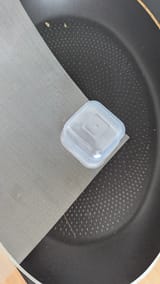>>2938766
Ants like having a nest that has various levels of moisture, so they can pick and choose where to keep brood or food and where to stay themselves. As such some way of moisturizing some area of the nest.
For acrylic nests (the ones you can often buy) that's often a sponge that touches one of the tunnels so the humidity is moved via the air. For most other nest types, it's usually some material that can transfer moisture, like gypsum or ytong.
Grout can move humidity, but only fairly limited, so we'll have to rely on the air as well similarly to an acrylic nest.
To do so, we use something called a "water tower", which is a reservoir that'll touch the tunnels that we can easily refill with water.
To do so you'll need your metal mesh and the small plastic container. Any container of similar size will do, bigger means less frequent refills. Those plastic tealight shells are popular for this use as well.
We'll melt the container onto the mesh with heat, so you'll also need a pan, preferably one you don't care much about.
I'm using a old nonstick pan that flaked off anyways, so I don't care about it, but if you don't have that you may be able to get away with either adding aluminum foil to protect the pan inbetween, using a lighter as a heat source rather than a pan, or just using some sort of glue instead (silicone would work well for example, anything that ants won't eat or isn't toxic).
Now we'll put the pan on high heat on the stove, and put our mesh into that pan to heat it up. Once sufficiently hot, slowly and carefully press the plastic container onto the mesh, so it melts and bonds with the mesh. Once that bonding is done, remove container and mesh from the pan and let cool. Too hot and the plastic burns and turns black (still works, just looks worse) too little heat and it won't bond properly. This is fairly easy to get right though.
